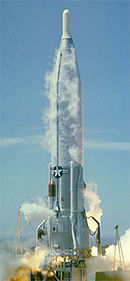Atlas III
This rocket article contains payload capacity, but does not include orbital altitude or inclination, which greatly affects the capacity. |
 The maiden flight of the Atlas III | |
| Has use | Medium expendable launch vehicle |
|---|---|
| Manufacturer | Lockheed Martin |
| Country of origin | United States |
| Size | |
| Height | 52.8 m (173 ft) |
| Diameter | 3.05 m (10.0 ft) |
| Mass | 214,338 kg (472,534 lb) |
| Stages | 2 |
| Capacity | |
| Payload to Low Earth orbit | |
| Mass | IIIA: 8,640 kg (19,050 lb) IIIB: 10,218 kg (22,527 lb) |
| Payload to Geostationary transfer orbit | |
| Mass | IIIA: 4,055 kg (8,940 lb) IIIB: 4,500 kg (9,900 lb) |
| Associated rockets | |
| Family | Atlas |
| Launch history | |
| Status | Retired |
| Launch sites | SLC-36B, CCAFS |
| Total launches | 6 (IIIA: 2, IIIB: 4) |
| Success(es) | 6 (IIIA: 2, IIIB: 4) [1] |
| First flight | IIIA: 24 May 2000 IIIB: 21 February 2002 |
| Last flight | IIIA: 13 March 2004 IIIB: 3 February 2005 |
| First stage | |
| Powered by | 1 RD-180 |
| Maximum thrust | 4,148.7 kN (932,700 lbf) |
| Specific impulse | 311 s (3.05 km/s) |
| Burn time | 132 seconds |
| Propellant | RP-1 / LOX |
| Second stage (Atlas IIIA) – Centaur (SEC) | |
| Powered by | 1 RL-10A |
| Maximum thrust | 99.2 kN (22,300 lbf) |
| Specific impulse | 451 s (4.42 km/s) |
| Burn time | 738 seconds |
| Propellant | LH2 / LOX |
| Second stage (Atlas IIIB) – Centaur (DEC) | |
| Powered by | 2 RL-10A |
| Maximum thrust | 147 kN (33,000 lbf) |
| Specific impulse | 449 s (4.40 km/s) |
| Burn time | 392 seconds |
| Propellant | LH2 / LOX |
The Atlas III (known as the Atlas II-AR (R for Russian) early in development [2]) was an American orbital launch vehicle, used in the years between 2000 and 2005.[3] It was the first member of the Atlas family since the Atlas A to feature a "normal" staging method, compared to the previous Atlas family members, which were equipped with two jettisonable outboard engines on the first (booster) stage (with a single center engine serving as the sustainer).
Description[]
The Atlas III consisted of two stages. The first stage was new, but the upper stage was the Centaur, which is still in use today on the Atlas V Evolved Expendable Launch Vehicle (EELV). The first stage engine was the Russian RD-180, which is also used by the Atlas V. The Atlas III was produced in two versions. The baseline was the Atlas IIIA, but the Atlas IIIB, featuring a twin-engine version of the Centaur upper stage, was also produced.[1]
Launches[]
The first flight of the Atlas III occurred on 24 May 2000, launching the Eutelsat W4 communications satellite into a geosynchronous orbit.[4] All Atlas III launches were made from Space Launch Complex 36B at Cape Canaveral Air Force Station (CCAFS). The Atlas III made its sixth and last flight on 3 February 2005, with a classified payload for the United States National Reconnaissance Office.[5][6]
GX[]
The GX rocket, formerly under development by Galaxy Express Corporation, was originally intended to use the boost stage of the Atlas III, provided by Lockheed-Martin, and a newly designed upper stage. It would have launched from the Tanegashima Space Center, south of Kyūshū, Japan. In December 2009, the Japanese government decided to cancel the GX project.[7]
See also[]
- Comparison of orbital launchers families
References[]
- ^ a b Space Launch Report: Atlas III Data Sheet accessed September 24, 2014
- ^ "Lockheed Martin Selects RD-180 to Power Atlas IIAR". International Launch Services. 17 January 1996. Retrieved 9 March 2013.
- ^ "Atlas IIIA". Encyclopedia Astronautica. Archived from the original on 1 July 2013. Retrieved 8 March 2007.
- ^ "Atlas-3A (Atlas-IIIA)". Gunter's Space Page. Retrieved 6 June 2020.
- ^ Ray, Justin (3 February 2015). "Last Atlas 3 rocket launches a pair of spy satellites". Spaceflight Now. Retrieved 6 June 2020.
- ^ Plain, Charlie. "NASA – Out With a Bang!". nasa.gov. Retrieved 6 June 2020.
 This article incorporates text from this source, which is in the public domain.
This article incorporates text from this source, which is in the public domain.
- ^ "Japan scraps GX rocket development project". iStockAnalyst. 16 December 2009. Archived from the original on 6 March 2014. Retrieved 16 December 2009.
- Atlas (rocket family)
- Lockheed Martin space launch vehicles

